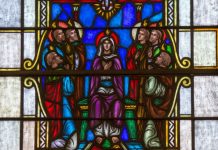
by Sister Alice Ann Pfeifer, CSA
For a list of animals in the Bible, see the end of this article.
Remember that old schoolyard rhyme that begins “No more rulers, no more books”? If you ever recited this little ditty when you were young, doubtless you remember how hard it was to sit still during those last days and hours of the school year.
Now you’re the teacher and you must deal with your students’ end-of-year restlessness. So why be like Sisyphus, the mythological character condemned for all eternity to roll a stone uphill only for it to tumble back down. Instead, resolve to channel your group’s energy into a fun and memorable way to sum up the year’s religious studies: Hold the 2010 Catholic Olympic Games in your classroom.
If you don’t usually work with a classroom assistant, this is one time when you’ll want the help of an adult or teenager. While you give instructions for each event and award points afterward, your assistant can distribute and collect materials and help keep general order.
Here are two sets of instructions for conducting your games, one set of ideas for students in the primary grades and one for students in the intermediate grades and up. Have fun!
Catholic Olympic Games for Primary Students
Remind students that Olympic athletes need to warm up before competing. The group’s warm-up activity will be for students to write their names on paper plates (one plate for each child), and to decorate the other side with words and pictures that show things they remember learning in religion class this year. Show students a sample that you have prepared ahead of time.
Tack plates, with names displayed, to a bulletin board or tape to a wall. Each time a student earns a point in the Catholic Olympic Games, Olympic rings or torch is drawn or affixed onto his or her plate (CLICK HERE for patterns).
First Event: Animal Freestyle Charades
You will need slips of paper on which you have written or pasted pictures of animals that are mentioned in the Bible. You also will need a basket for the slips of paper.
Tell “athletes” that the Bible mentions many different animals.
Have athletes take turns being IT. IT draws a slip from the basket and mimics—without any sound whatsoever—the habits and motions of the animal drawn. IT can act the way the animal walks, runs, eats, swims, crawls, flies, etc. If IT doesn’t know what to do, he or she may ask you to whisper a hint. The first athlete to guess the animal being portrayed by IT wins a point. IT can win a point if he or she can name the circumstance in which the animal is mentioned in the Bible. (See end of article for a list of animals in the Bible.)
Second Event: Faith-Statement Challenge
You will need a list of faith statements that the students need to complete.
Read the first part of a faith statement to an athlete. You can use lines from prayers (“What is the next line in this prayer: ‘Our Father who art in heaven…’”), Mysteries of the Rosary (“The first Joyful Mystery is…”), the Ten Commandments (“The Third Commandment is…”), statements about the Sacraments or Christian symbols or familiar hymns (“‘Amazing grace…’ What comes next?”). Make sure every athlete gets a chance to complete a faith statement. A correctly completed faith statement results in the athlete getting a point.
Third Event: Tic-Tac-Toe Relay Race
You will need a large tic-tac-toe grid drawn on newsprint or poster board. Hang the grid in a spacious area. You also will need 10 sticky notes, five displaying a drop of water and five displaying a dove. (For additional races, you might want to make more sets of sticky notes: a host and a chalice; Jesus and sheep; etc. Be sure to review with students what each symbol means.) You will also need two throw pillows about the size of a child’s head and a roll of masking tape.
Divide athletes into two teams of five. Give each athlete on one team a sticky note with a drop of water on it. Give each athlete on the other team a sticky note with a dove on it. See if athletes know what Sacrament those symbols represent. Press a piece of masking tape on the floor in front of the first person on the team to indicate the start/finish line.
Line up teams side by side, one team member behind the other. On the word “Go,” the first person on each team puts a throw pillow on his or her head, moves toward the tic-tac-toe grid, and places a sticky note on the grid. If the pillow falls off, the athlete needs to return to the start/finish line and start over. When the athlete successfully reaches the tic-tac-toe grid and puts a sticky note in place, he or she takes the pillow off and rushes back to the team member next in line. The first team to get a tic-tac-toe wins, and each winning team member gets a point.
Fourth Event: Hymn Hum-Athon
You will need to select from a parish hymnal those hymns that students should know, including seasonal ones such as “Silent Night” and “Jesus Christ Is Risen Today.”
As individuals, in pairs, or in teams, athletes guess the hymn you sing—but you are not singing. Hum the hymn or sing it only with la-la-la and/or da-da-da. Athletes get a point for every hymn they guess correctly.
The Awards Ceremony
You will need prizes, at least one for each athlete. (Even low scorers are winners in the Kingdom of God.) You may want to make gold, silver, and bronze medals out of pieces of construction paper or poster board attached to ribbon. You might want to invite the two students who scored the most points to help you distribute prizes. Small religious articles make great prizes.
While students are receiving their prizes, take down the paper plates. Then remind students that together we all belong to the family of God—and family members pray for one another. As a final activity in your Catholic Olympics Games, each child is going to receive another child’s paper plate. This plate will remind the student throughout the summer to pray for the person whose name is on the plate.
Distributing the plates is going to create a lot of movement, so you will need an open space. Have students stand together in a group. They will try to catch a paper plate as you toss them, one by one, into the group, Frisbee-style. When a child catches a plate, he or she leaves the group and waits until every child has one. (Do not allow students to trade plates. We are family, and we pray for each other, even those with whom we may not be good friends or know very well.)
Then have students join together in a circle for a prayer to officially close the 2010 Catholic Olympic Games. “Loving God, please keep everyone in this family circle safe and happy this summer. Guard us all in body, mind, and soul, especially the classmates for whom we promise to pray. We ask you these things through Christ our Lord. Amen.”
Just for Fun
National anthems are played at Olympics games. You may want to help your students create an anthem for their Catholic Olympic Games. Select something that is moving and upbeat, such as “When the Saints Go Marching In.” Or perhaps athletes might write their own anthem to a popular tune. A fun way to sing your anthem is to form a circle and, going from athlete to athlete in a clockwise direction, have athletes take turns singing only one word at a time.
Catholic Olympic Games for Intermediate Students
As a warm-up activity, use the same activity described above.
First Event: Take-Your-Pick Slopes
You will need slips of paper and two wide-mouthed jars. On some of the slips of paper, write questions about things students learned this year: What is a Sacrament? What is the Triduum? When do we celebrate the Assumption of Mary? On some of the slips of paper, write vocabulary words students should know: evangelist, Beatitudes, Responsorial Psalm. Place the questions in one jar and label the jar “Q and A.” Place the vocabulary words in the other jar and label it “Charades.”
Have each athlete, one by one, step forward and choose a slip of paper from one of the jars. If the athlete selects from the “Q and A” jar, take the slip, read the question, and allow the athlete one minute to respond. If the athlete selects from the “Charades” jar, he or she acts out the word, allowing one minute for the right answer to be guessed by any other athlete. Every question correctly answered or charade correctly guessed wins the athlete a point. The athlete correctly identifying the charade also wins a point. (The athlete acting out the charade can raise the number of fingers to indicate the number of syllables in the word.)
Second Event: Scrabble Singles
You will need a pencil and a sheet of grid paper for each student.
Give athletes a “first word” to print in the center of the grid on their papers, SACRAMENT for example. Then have athletes add related words to the grid, Scrabble-style, that can be spelled using letters in the first word. For example, BAPTISM can be positioned in the grid by placing the B above the first A and P, T, I, S, and M below the A. Now other words, still associated with SACRAMENT, can be built off both words. All words in the grid must be associated with SACRAMENT. Or your first word might be ABRAHAM, and athletes have to come up with names of people in the Bible. No word may be repeated in the grid.
Declare “Go” and allow athletes five minutes to add words to their grids. On the word, “Stop,” have athletes put down their pencils and begin counting their words. Determine who has the most words and have that person read his or her list aloud. Question the athlete about any word you think may not fit into the assigned category. If the athlete’s explanation satisfies you, let the word stand. Then ask if anyone has words that were not already mentioned. Let those athletes read their words; question all words that do not seem to fit the category. Award three points to the athlete(s) with the most accepted words in the grid; two points to the athlete(s) with the second most number of words; and one point to the athlete(s) with the third most number of words.
Third Event: Tic-Tac-Toe Relay Races
You will need a large tic-tac-toe grid drawn on newsprint or poster board. Hang the grid in a spacious area. You also will need a green thick-tip marker, a red thick-tip marker, two magazines of approximate equal size and number of pages, and a roll of masking tape.
Divide athletes into two teams of five, the Green Team and the Red Team. Line up teams side by side, one team member behind the other, at a start/finish line that you have indicated with a piece of masking tape on the floor. On the word “Go,” the first person on each team places a magazine on his or her head, moves toward the tic-tac-toe grid, picks up the team’s colored marker, and writes in an area of the grid a Beatitude, a Sacrament, a Commandment, a Gift of the Holy Spirit—whatever you have determined to be the focus of the relay. When the athlete finishes writing, he or she removes the magazine from the head and dashes back to the next team member in line, who repeats the process.
Entries may not be repeated except if both the Green Team and the Red Team athletes happen to write the same thing at the same time. If an athlete cannot think of something new to add, he or she must run back to the starting line and let a teammate try. The first team to get a tic-tac-toe wins, and each winning team member gets a point.
Fourth Event: Hymn Hum-Athon
Play this game as it is described for younger students.
The Awards Ceremony
Award age-appropriate prizes to the athletes as described for younger students. Also use the same activity with paper plates. You may wish to add a chance for the students to give one another the Sign of Peace and to autograph one another’s paper plates. End by forming a circle and saying the closing prayer used in the primary student Catholic Olympic Games.
Just for Fun
If your classroom has blackboards, “Blindfolded Artist” is a quick and simple game. Send one athlete at a time to the blackboard, give him or her a piece of chalk, and then blindfold the athlete. Instruct the athlete to draw a simple Bible scene, such as the angel appearing to Mary at the Annunciation, Jesus walking on water, or John the Baptist standing in the Jordan River. If you’re keeping score, the athlete receives a point if his or her drawing can be identified.
Sister Alice Ann Pfeifer, CSA, has been a Sister of St. Agnes for over 30 years and a religion teacher and writer for the past 20 years. She has a master’s degree in pastoral studies from St. Joseph’s College of Maine.
Animals in the Bible
Here is a list of animals in the Bible and a suggestion for the circumstance in which each is mentioned.
BIRD/DOVE: The Holy Spirit appeared in the form of dove at Jesus’ baptism (Luke 3:22).
CAMEL: Jesus said it is easier for a camel to pass through the eye of a needle than for a rich person to get into heaven (Mark 10:25).
DOGS: Dogs licked Lazarus’ sores (Luke 16:21).
DONKEY/ASS: Before he was arrested and crucified, Jesus rode into Jerusalem on a donkey (Matthew 21:2).
FISH: A great fish swallowed Jonah (Jonah 2:1).
FROG: A plague of frogs afflicted Egypt (Exodus 8:1).
GOAT: Jesus said that at the last judgment, people will be separated like sheep from goats (Matthew 25:32).
HORSE: Egyptian soldiers chased the Hebrews in horse-drawn chariots (Exodus 14:9).
LION: David killed a lion while protecting his sheep (1 Samuel 36).
LOCUST/GRASSHOPPER: John the Baptist ate grasshoppers in the desert (Matthew 3:4).
OX: Jesus cleared the temple area of money-changes and those who were selling oxen, sheep, and doves (John 2:14).
PIG/SWINE: Jesus cast evil spirits into a herd of pigs (Mark 5:11-13).
ROOSTER/COCK: A rooster crowed after Peter denied Jesus three times (Matthew 26:75).
SHEEP: Jesus is the Good Shepherd and we are his sheep and follow his voice (John 10:27).
SNAKE/SERPENT: Satan appeared to Eve in the form of a snake (Genesis 3:1).
WOLF: In the Kingdom of God, the wolf and the lamb shall graze together (Isaiah 65:25).
Copyright 2010, Bayard, Inc. All rights reserved. This article is protected by United States copyright and other intellectual property laws and may not be reproduced, rewritten, distributed, redisseminated, transmitted, displayed, published or broadcast, directly or indirectly, in any medium without the prior written permission of Bayard, Inc.
This article was written by the Catechist Staff and appeared in Catechist magazine, February 2010.
Image Credit: Shutter Stock 315555992




